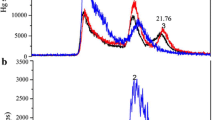Abstract
Rats were injected subcutaneously with either cadmium chloride (0.5 mg Cd/kg) or mercuric chloride (0.5 and 0.25 mg Hg/kg) every other day over a period of 6 to 7 weeks. Levels of metals and metallothionein were determined in liver and kidneys. Both cadmium and metallothionein accumulated in these organs during the period of exposure. Mercury and metallothionein accumulated only in the kidneys. Mercury did not accumulate in the liver, nor did it cause an increase of metallothionein in the liver. The molar ratio of 1.6 (metal to metallothionein) in liver was constant for cadmium. In the kidneys this ratio varied from 1 to 3 for both metals, depending on the level of the metal; This ratio was 0.1 for liver mercury.
Zusammenfassung
Ratten erhielten Kadmiumchlorid (0,5 mg Cd/kg) oder Quecksilberchlorid (0,5 und 0,25 mg Hg/kg) alle 2 Tage s.c., 6 bis 7 Wochen lang. Der Spiegel von Metallothionein wurde in Leber und Nieren bestimmt. Sowohl Cadmium wie Metallothionein kumulierten in diesen Organen während der gesamten Expositionszeit. Quecksilber und Metallothionein kumulierten ausschließlich in den Nieren, nicht in der Leber. Das molare Verhältnis Metall:Metallothionein in der Leber war für Cadmium konstant und betrug 1,6. In den Nieren änderte es sich von 1∶3 für beide Metalle, in Abhängigkeit vom Spiegel des Metalls. Für Quecksilber betrug dieses Verhältnis in der Leber 0,1.
Similar content being viewed by others
References
Elkins, H. B.: The chemistry of industrial toxicology. New York: John Wiley 1959
Fang, S. C.: The in vivo kinetics of mercury binding of kidney soluble proteins from rats receiving various mercurials. In: Mercury, mercurials and mercaptans (Miller, M. W., Clarkson, T. W., Eds.). Springfield, Ill.: G. C. Thomas 1973
Jakubowski, M., Piotrowski, J. K., Trojanowska, B.: Binding of mercury in the rat: Studies using 203HgCl2 and gel filtration. Toxicol. appl. Pharmacol. 16, 743–753 (1970)
Kägi, J. H. R., Vallee, B. L.: Metallothionein; a cadmium and zinc-containing protein from equine renal cortex. J. biol. Chem. 235, 3460–3465 (1960)
Lowry, O. H., Rosebrough, N. J., Farr, A. L., Randall, R. J.: Protein measurement with the Folin phenol reagent. J. biol. Chem. 193, 265–275 (1951)
Nordberg, G. F., Piscator, M., Lind, B.: Distribution of cadmium among protein fractions of mouse liver. Acta pharmacol. (Kbh.) 29, 456–470 (1971)
Nordberg, G. F., Nordberg, M., Piscator, M., Vesterberg, O.: Separation of two forms of rabbit metallothionein by isoelectric focusing. Biochem. J. 126, 491–498 (1972)
Nordberg, M., Trojanowska, B., Nordberg, G. F.: Studies on metal-binding proteins of low molecular weight from renal tissue of rabbits exposed to cadmium or mercury. Environ. Physiol. Biochem. (in press) (1974)
Piotrowski, J., Bolanowska, W.: Wiazania octanu fenylortceciowego 203Hg w ustroju szczura, badane technikca scaczenia molekularnego. (Binding of phenyl-mercury acetate 203Hg in the body of rat, studied by molecular filtration technique). Med. Pracy 21, 338–348 (1970)
Piotrowski, J. K., Bolanowska, W., Sapota, A.: Evaluation of metallothionein content in animal tissues. Acta biochim. pol. 20, 207–215 (1973)
Piotrowski, J. K., Trojanowska, B., Wiśniewska-Knypl, J. M., Bolanowska, W.: Mercury binding in the kidney and liver of rats repeatedly exposed to mercuric chloride; induction of metallothionein by mercury and cadmium. Toxicol. appl. Pharmacol. 27, 11–19 (1974)
Piscator, M.: On kadmium i normala människonjurar sanit redogörelese für isolering av metallothionein ur level fran kadmium exponerade kaniner. (Cadmium in normal human kidneys and report on the isolation of metallothionein from livers of cadmium-exposed rabbits). Nord. hyg. T. 45, 76–82 (1964)
Pulido, P., Kägi, J. H. R., Vallée, B. L.: Isolation and some properties of human metallothionein. Biochemistry 5, 1768–1777 (1966)
Shaikh, Z. A., Lucis, O. J.: Cadmium and zinc binding in mammalian liver and kidneys. Arch. environm. Hlth 24, 419–425 (1972)
Webb, M.: Binding of cadmium ions by rat liver and kidney. Biochem. Pharmacol. 21, 2751–2765 (1972a)
Webb, M.: Protection by zinc against cadmium toxicity. Biochem. Pharmacol. 21, 2767–2771 (1972b)
Wiśniewska, J. M., Trojanowska, B., Piotrowski, J., Jakubowski, M.: Binding of mercury in the rat kidney by metallothionein. Toxicol. appl. Pharmacol. 16, 754–763 (1970)
Wiśniewska-Knypl, J. M., Jabłiońska, J.: Selective-binding of cadmium in vivo on metallothionein in rats liver. Bull. Acad. pol. Sci., Ser. Biol. 18, 321–327 (1970)
Wiśniewska-Knypl, J. M., Trojanowska, B., Piotrowski, J. K., Jabłońska, J.: Binding of mercury in rat liver by metallothionein. Acta biochim. pol. 19, 11–18 (1972)
Author information
Authors and Affiliations
Additional information
This work was partly supported by the Polish-American agreement No. 05-009-2 with National Institute for Occupational Safety and Health, PHS, USA.
Rights and permissions
About this article
Cite this article
Piotrowski, J.K., Trojanowska, B. & Sapota, A. Binding of cadmium and mercury by metallothionein in the kidneys and liver of rats following repeated administration. Arch. Toxicol. 32, 351–360 (1974). https://doi.org/10.1007/BF00330118
Received:
Issue Date:
DOI: https://doi.org/10.1007/BF00330118
Key words
- Cadmium, Organ Levels in Repeated Exposure
- Mercury, Organ Levels in Repeated Exposure
- Metallothionein, Binding of Cadmium and Mercury
- Metallothionein, Induced Biosynthesis




